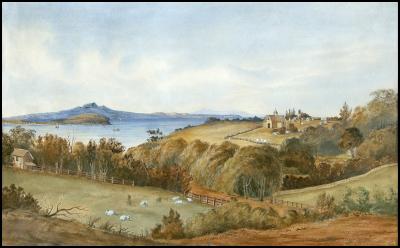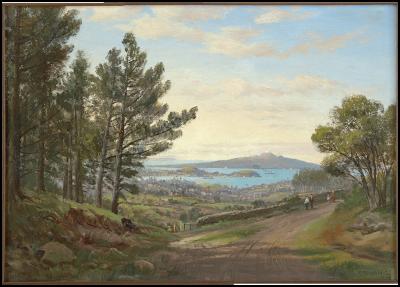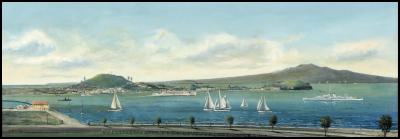Auckland – A History in Paintings
Media Release
17 April 2009
Auckland – A History
in Paintings
23 April – 20 May 2009

Click for big version
John B C Hoyte_Judges Bay (Taurarua) and St Stephen's Chapel, c 1860

Click for big version
Charles Blomfield_Auckland Harbour from Mt Eden, 1920

Click for big version
E Armitage_HMS Achilles on her return from the Battle of the River Plate, February 1940
A visual narrative of Auckland,
covering the time of the early European settlers until
recently, is captured in a landmark art exhibition at
Jonathan Grant Galleries in Parnell.
Titled “Auckland – A History in Paintings”, the exhibition runs from 23 April to 20 May 2009.
Spanning two centuries, artists have expressed important moments in the historical cultural and physical transformation of Auckland’s urban landscape and harbour. The 22 paintings include several exceptionally rare works.
Curating the exhibition has been a 10 year effort on the part of art dealer Jonathan Gooderham. All the works are for sale.
Included in the exhibition is a major rediscovery of a Second World War painting of HMS Achilles. Jonathan Gooderham says, “It has been a mission collecting – and retaining – these paintings. The most exciting and rewarding part has been the results of the research into their histories. The premier example is the 1940 oil by Armitage, which was previously merely catalogued as ‘Waitemata Harbour’. However, a hunch and a little research in my library confirmed my initial thoughts that the vessel in the foreground was HMS Achilles on her return from the Battle of the River Plate.”
The
paintings support a chronological map of Auckland’s
evolution from the 1840s to the 2000s.
In the
course of Auckland’s history of European settlement, John
Logan Campbell pitched his tent in Commercial Bay in 1840.
He went on to build one of the first permanent houses in
Auckland in 1841. In 1846 Lieut. Colonel Wynyard painted a
watercolour from Official Bay depicting his home amongst the
undeveloped fields of Point Britomart. This painting is
included in the exhibition, alongside another one painted in
1849, featuring the old St Paul’s Cathedral and the
Britomart Barracks. These bare landscapes provide a visual
interpretation of John Logan Campbell’s description of
Auckland from his 1840 book Poenamo – “No fiction
enters into it. Only a single ship, a few tents and
break-wind huts, and a handful of the Saxon race. They have
planted their feet in a far distant land and in a little
time to what a great end this small beginning shall
grow.”
Other early art works include The Rev John Kinder’s 1850s watercolour of Parnell, as well as the 1860s view of ‘Auckland Harbour NZ’ from Courthouse Hill by Sir Henry James Warre KCB of Commercial Bay and featuring North Head and Rangitoto in the distance. Sir Henry arrived in Auckland from India with his regiment for service in the Maori Wars. John Kinder emigrated to New Zealand in 1855. As a young English artist, Kinder settled in the Parnell district. His watercolour ‘The Church of England Grammar School, Parnell, from the site of Master’s House’ shows the sparse landscape of the Auckland settlement in the late 1850s without a single house visible in the area now known as Remuera, Newmarket and Epsom. The School to which Kinder refers was established in 1855 by Bishop Selwyn as a cathedral school of the diocese with Kinder as Principal, and was built on the corner of Parnell Road and Ayr Streets. The Master’s House, where Kinder and his family lived for 15 years from 1857, still stands today and is known as Kinder House. In this same decade John Barr Clarke Hoyte, who coincidentally was drawing master at Kinder’s school, painted the newly built St Stephen’s Chapel in Judges Bay (Taurarua) around 1860. This is amongst the finest examples of Hoyte’s works. While history has identified Hoyte as a painter, he was also a respected teacher who was a founding staff member of Auckland Grammar. Frank Wright, a fellow teacher and avid artist, also provides a scene from Auckland’s early history. He depicts the scows of Cox’s Creek, Westmere, unloading logs destined to be used for building houses in Herne Bay and Ponsonby.
The visual history of Auckland that this collection presents is further supplemented by E Armitage’s portrayal of the return of HMS Achilles to Auckland on 23 February 1940. On this day, the crew marched through Auckland on their victorious return from the Battle of the River Plate. Armitage portrays HMS Achilles safely anchored off North Head; the (now mature) pohutakawa trees along the Tamaki waterfront are but saplings at this time. Finally, Charles Decimus Barraud presents the view looking across Parnell from the road to Mount Eden in 1874 with Parnell’s Bishopsgate and St Mary’s Church at the top of St Stephens Avenue in the distance.
In a contemporary twist, the exhibition canvases the Auckland harbour from colonisation to present day. Paul Hooker’s painting of the Viaduct Basin in the 1990s presents it as a busy fishing and maritime engineering location prior to the area being completely rebuilt to house the America’s Cup Village, as seen in Josephine Davis’s watercolour of the super yachts painted in the year 2000 during New Zealand’s landmark America’s Cup victory over Luna Rossa.
ENDS


 Organ Donation NZ: Organ And Tissue Donation Helped Save And Improve The Lives Of Hundreds Of People In 2024
Organ Donation NZ: Organ And Tissue Donation Helped Save And Improve The Lives Of Hundreds Of People In 2024 Taupo District Council: Punarua Exhibition Arrives At Taupō Museum
Taupo District Council: Punarua Exhibition Arrives At Taupō Museum Office of Early Childhood Education: Teachers Are Paying The Price For Lack Of ECE Funding In The Budget
Office of Early Childhood Education: Teachers Are Paying The Price For Lack Of ECE Funding In The Budget Science Media Centre: Teen Dies After Controversial Tackle Game – Expert Reaction
Science Media Centre: Teen Dies After Controversial Tackle Game – Expert Reaction Howard Davis: The Amici Ensemble Provide A Master Class In Françaix, Fauré, & Brahms
Howard Davis: The Amici Ensemble Provide A Master Class In Françaix, Fauré, & Brahms Burnett Foundation Aotearoa: Local HIV Diagnoses In Decline, Challenges To Achieving Elimination Goal
Burnett Foundation Aotearoa: Local HIV Diagnoses In Decline, Challenges To Achieving Elimination Goal